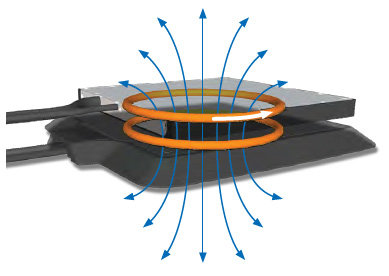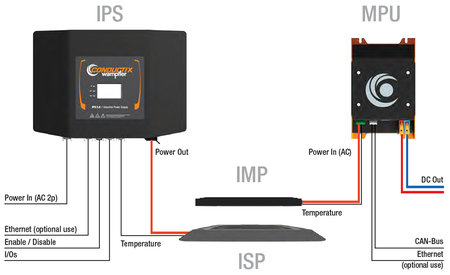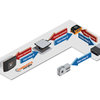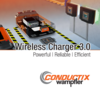Contactless Opportunity Charging: Wireless Charger 3.0 – Powerful | Reliable | Efficient
From the electric toothbrush to the fully automated guided vehicle system
Charging of electric vehicles in the industry is done with charging cables, as with forklifts for decades, is a common sight. Or the empty battery is exchanged for a full one. Typically, however, both are solutions that very quickly reach their limits in the automated operation of automated guided vehicles (AGVs), as they cannot be automated or can only be automated at great expense. The use of charging contacts can be the solution here. They are compact, have proven themselves, are easy to understand, inexpensive to purchase and can be integrated in various arrangements. So all in all, not a bad solution to automate charging processes. Conductix-Wampfler, one of the world's leading manufacturers of energy and data management systems for mobile equipment, with its own claim to be a full-liner and the goal to offer customers the choice of the most suitable solution, has launched a new product range. The WirelessCharger 3.0 is a solution for charging energy storage devices that relies on inductive energy transmission and thus enables contactless, automated battery charging.
Inductive power transfer is not new. Conductix-Wampfler has been using the technology successfully for more than 20 years and has set a new industry standard with its Inductive Power Transfer (IPT) solution for continuous, contactless power transmission for vehicles that do not have batteries on board. In private, many people use an inductive transfer solution on a daily basis without probably realizing it. But charging electric toothbrushes is done inductively. Faraday, Maxwell, later Tesla and others researched and created the basis for this technology long ago. The basic principle is very similar to that of a transformer. However, in order to make the system flexible and movable, i.e. practical for vehicle solutions, the iron core had to be omitted. Today we speak of a system consisting of two main blocks with individual coils - the stationary primary side and the mobile secondary side. The primary side generates a higher frequency AC voltage from the mains voltage. The current flowing through the primary coil generates a magnetic field around the primary coil. This in turn induces a current in the counter-coil on-board the vehicle, which is converted into a DC voltage in a coupled electronic unit. This can be used directly for battery charging. The system receives the current charging demand via a communication interface, typically directly from the battery management system (BMS). The energy transfer is adapted to the reported demand, which makes the overall system even more efficient.

If the solution principle has been known for a long time, why is such a solution only coming onto the market today?
This is not least due to the demand situation. A forklift in single-shift operation can be loaded without any problems during the time when it is not in use. The plugging and unplugging process was tolerated. Today we see an increasing number of driverless vehicles in logistics. These have to facilitate high throughputs. Trends like globalization and steady growth of e-commerce are major drivers. The availability of vehicles is becoming a critical efficiency and throughput criterion and the requirements can only be met in automated operation.
Wireless, inductive charging is predestined for automated charging. The dimensions and the solution concept allow a flexible implementation and the possibility to apply the principle of opportunity or in-process charging. This means that even short time slots during operation can be used for charging while the vehicles are stationary. These can be buffering sections or waiting areas before and during the transfer of the transported goods. Time slots that are basically already given by the processes in production or logistics. The number of vehicles does not have to be increased because vehicles are standing apart in a loading area or are on their way to or back from there to their area of operation. Ideally, such loading areas can be completely eliminated, which in turn makes space available for other purposes. Another positive "side effect" of opportunity charging is the short but regular charging processes, which reduce the thermal stress on the batteries and thus make a positive contribution to their service life. With plannable energy requirements and regular intermediate charging, the battery capacities that would otherwise be required can be limited and states of charge (SOC) in the lower and upper range can be avoided. Ranges that place stress on the batteries and thus have a negative impact on the life cycle of the batteries. Advantages that can basically also be tapped with charging contacts such as Enduro+ from Conductix-Wampfler. These also meet high reliability requirements.
What the WirelessCharger 3.0 offers in addition to all these advantages is the mechanical wear-free energy transmission, as this is contactless. The WirelessCharger 3.0 also does not require a fan, so there is also no mechanical wear and therefore no maintenance in this area. Maintenance is limited to a visual status check and, in the case of a very high degree of contamination, surface cleaning. There are no open contacts on the coils or pads. They are completely encapsulated, thus safe to touch, and are extremely robust against environmental influences. The absence of mechanical abrasion means that wireless charging systems can also be used in areas that are fundamentally sensitive to contamination, such as clean production areas in the pharmaceutical or food industries. With the encapsulation of the coils and the high protection levels of all components, no further safety precautions need to be implemented. Contactless battery charging can be integrated into the process. The small footprint and the horizontal as well as vertical installation options allow a very flexible integration into the processes and a great freedom in positioning in production lines or storage pre-zones.

Two arguments are repeatedly used against inductive solutions: cost and efficiency
In principle, the system costs are higher at first glance than for charging contacts or charging segments. However, the initial costs of a system do not allow any conclusion to be drawn about the actual costs (Total Cost of Ownership TCO). Expenditures for direct costs such as wear parts and indirect costs such as maintenance expenses should always be considered. A direct comparison is actually not possible either, since a wireless charger represents a system approach, while charging contacts are a system component and further equipment such as a power supply is necessary. Furthermore, many conductive charging solutions do not allow demand-oriented charging as they have a fixed charging voltage. This severely limits the usability of the battery capacity, as charging cannot be optimized. Wireless charging adapts to the requirements and delivers the required charging voltages and currents. Of course, this also has an influence on the actual operating costs of a material handling or conveyor system.
The efficiency of current inductive energy transmission solutions is much higher than the "general gut feeling" usually gives them credit for. The use of state-of-the-art electronics and the use of high frequencies for transmission result in efficiencies that do not need to hide behind plug-in chargers. Even these, contrary to the already quoted gut feeling, do not work with an efficiency of 100%. The electrics, the electronics and not least the contacts also add up as losses here, which rise further with increasing wear. In direct comparison to a highly efficient plug-in charger, the air gap in a wireless charging solution results in additional losses in the low percentage range. As soon as the plug-in charger does not meet the highest efficiency requirements, the perspective shifts significantly, since only state-of-the-art electronic components are used in the WirelessCharger 3.0 from Conductix-Wampfler.
In summary, the WirelessCharger 3.0 optimally complements the Conductix-Wampfler solution portfolio. It includes most of the advantages of traditional charging solutions and adds a whole range of specific advantages. If not only the initial costs are considered and thus apples are compared with oranges, the Wireless Charger represents a highly interesting alternative and supplement to the charging solutions available to date, and not only for special application scenarios.








